
|   |

|   |
Rang Swadheenta - Tapati Chowdhurie e-mail: tapatichow@yahoo.co.in August 28, 2023 'Rang Swadheenta' was a one-of-its-kind festival celebrated before our Independence Day - on the 12th and 13th of August at Central Vista, India Gate, Delhi. The event highlighted the country's timeless culture and upheld the P.M's vision and campaign of "Har Ghar Tiranga." Chairman of Sangeet Natak Akademi, Sandhya Purecha in her formal inauguration of this unique festival offered her gratitude to those who fought relentlessly and sacrificed their lives to give the country its independence. The pre-independence celebration laid emphasis on the rich cultural heritage of the country. The two day long festival was made meaningful by the nritya sanrachanas of eminent dance gurus highlighting the age old artistic legacies and soft power of the land that have caught the attention of the world as opposed to hard power which signifies wars of various kind to subjugate nations. And one such idea or philosophy that has been India's wealth from time immemorial is Vasudaiva Kutumbakam - which means the world is one family. 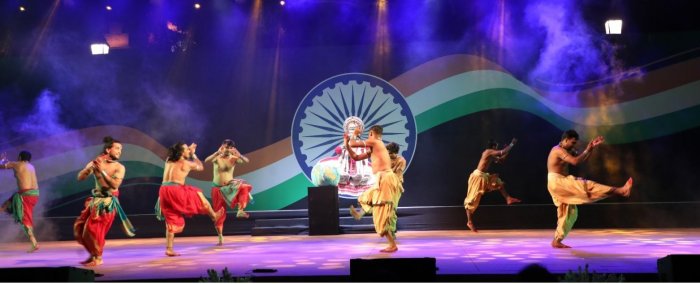 Shashadhar Acharya's group Chhau dance exponent Shashadhar Acharya's choreographic work "Vasudaiva Kutumbakam" had much clarity in its presentation. With brevity, he has visualised the extinction of this beautiful world, because of the lack of far-sightedness and evil machinations of some, which can only be prevented by a joint effort. His motifs of good and evil were Ram and Ravan. To Ram the whole living world is his kutumb or family; through his kutumb he vanquishes evil. The message of the sanrachana spelled out the ideology and story of Bharat as visualised by the ruling party. Bharat has whole-heartedly embraced the idea Vasudaiva Kutumbakam once again. It has taken many steps forward towards implementing it such as supplying medicine to the world during pandemic times; reaching out to people during natural disasters; rescuing citizens of war hit countries etc. She has also made a display of the philosophy of Vasudaiva Kutumbakam by sharing with the world her knowledge of Yoga. In the last scene, Shashadhar Acharya gave a clarion call to the seven continents of the world -with dancers waving seven flags on the proscenium stage representing the seven continents - to follow his message of Vasudaiva Kutumbakam for the preservation of mankind along with other living beings. Chetan Joshi's music score did much to enhance the quality of the presentation. Appropriate bird song and sounds of nature beautified it. Soft lyrical music was intertwined with war music tellingly. Milind Srivastav, the lighting expert, produced the proper ambience needed with his magical touch. The Kathakali artiste Kalyana Krishnan Nair, whose chutti makeup artiste was Unnikrishnan Pillai, provided life that made the combat between him and the Seraikella Chhau artiste meaningful. The two styles perhaps were pitted together for the first time, thanks to Shashadhar Acharya's creative mind. Besides Chhau dancers Sukant Kumar Acharya and Sachin, the sanrachana used Odissi dancers Sushant Maharana, Priyanka Das, Arohi Agarwal, and Sangeeta Bose, Contemporary dancers Sunny Thakur, Nitin Kumar, Jay Singh and Sachin, Kathak dancers Ganya Sethi, Soumya Narang, Nikhil Parihar and Siddhant Purohit. Kuleswar Kumar Thakur, Deepak Kandari, Mahesh Rautela and Rohit Lal Kanojia were the Yoga artistes. It was a spectacular show. 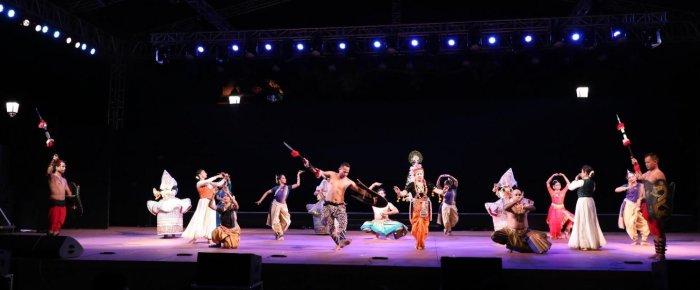 Priti Patel's group Manipuri dance exponent Priti Patel's sanrachana of 'Aikyam' dealt with the concept of "Unity in Diversity". In Aikyam, which means harmony, the different dance and music traditions of India were shown coming together in a harmonious mosaic creating an unforgettable image of the deep cultural roots of India and its heritage, a heritage that every Indian is proud of. Our ability to reach unity in diversity is the beauty and test of our civilisation. The choreographer has established her concept through the traditions of Manipuri dance, Bharatanatyam, Kathak and Odissi - the cultural diversity of the different forms are representative of Bharat. The narrative was in the voice of Sadhana Shrivastav in her clear diction. Samar Das provided the lights. A shloka at the commencement professed happy and auspicious days, free from illness and suffering for all living souls. The Kathak piece presented was in raag Kirwani. Shumar or ginti - counting of numbers - in a four beat taal was composed by Ustad Sabir Khan and choreographed by both Sohini Debnath and Debashree Bhattacharya, both students of Rani Kaarna. Suitably costumed, their gintis and other technicalities of the genre created an aura and left the audience spellbound. In Odissi, Saswati Garai Ghosh and her group performed 'Prarambh' - an ode to supreme consciousness, where Vishnu, the preserver is the lord of truth, purity and truth resonates in our consciousness and makes our journey harmonious. Choreographer Saswati selected this piece of Jagadguru Bharathi specially for this program the music of which was composed by Srijan Chatterjee and vocalised by Rupak Parida, while Bijay Kumar Barik composed the rhythms. Saswati's disciples Agnisha Basak, Joyita Pal, Parama Das Samanta accompanied her on dance. Bharatanatyam guru Rajdeep Banerjee and his disciples performed a Ganapati stuti "Sri Vignarajam Bhaje" by Oothukadu Venkata Subbaiyer in ragam Gambheera naattai, talam kandam. It was a song about him who has the face of an elephant, son of Parameshwara and Parvathi. In the charanam, the bhaktas say that he is worshipped by Indra and is an epitome of greatness. He blesses those who chant his name and meditate on him. He is the embodiment of ultimate truth that leads to salvation. Rajdeep's talented co-dancers were Rittick Bhattacharya, Moumita Gupta and Shreya Pramanick. Aikyam highlighted the concept of Vasudaiva Kutumbakam - one earth, one family, one future. Aikyam sought harmony where there was none, upholding the inherent interdependence of all elements with a unified whole, where each classical style is representative of one region of our country... unique, vibrant, and distinct. Priti Patel's choreography attempted to locate the underlying thread that binds us all together. It could be rhythm which like the heartbeat, pulsates through the weft and warp of our culture. Priti Patel's own students who were part of Aikyam were: K.Ratan Singh and N.Surjit Singh performed Pung Cholom - dancing and playing of the Manipuri drum while at the same time performing acrobatic movements. In Thang-Ta, which is basically a martial art form with sword and shield, artistes Th Imocha Singh, K. Sushil Singh and S. Robert Meitei showed their ability to wield the sword and the shield in myriad formations and combats while the audience held their breath. Manipuri Raas dancers S. Karuna Devi, P. Nongpokganbi, M.Saitabala, W. Shiyalakshmi Devi created a dream like atmosphere with the celestial dance of Radha and Krishna. It was the choreographic skill of Priti Patel who was able to choose from the cream of classical dancers of Kolkata from different genres to display their art form to viewers in Delhi. Music of the piece was composed by Kumar Bannerjee. 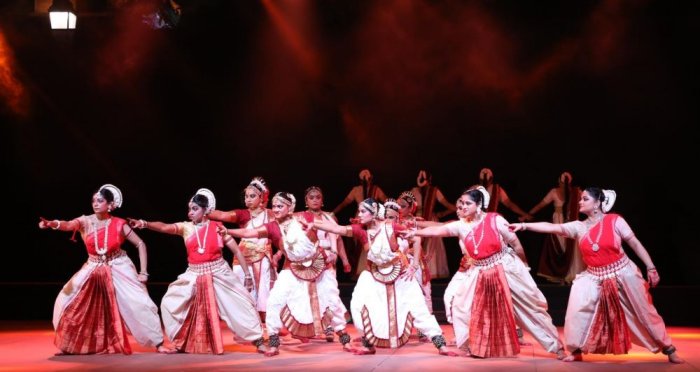 Mangala and Raghav Raj Bhatt's group 'Rang Swadheenta,' a unique choreography by Kathak dancers Mangala and Raghav Raj Bhatt featuring four Indian classical dance forms - Kathak, Odissi, Bharatnatyam and Kuchipudi - was a tribute to the extraordinary individuals Alluri Sitaramaraju, Subash Chandra Bose, Rani Lakshmi Bai and Mahatma Gandhi, who were a part of the fight for India's independence. The dancers selected were top graded artistes. Watching them was delightful. The choreographers celebrated the resilience and unity of the Indian people, through the seamless integration of classical dance forms, evocative poetry, and soul-stirring music. This production took the audience on a nostalgic journey through history, leaving them with a renewed sense of patriotism and appreciation for the freedom we cherish till date. Rang Swadheenta is a unique production that celebrated the spirit of India and took pride in observing Azadi ka Amrit Mahotsav. The audience was taken on a journey to savour the rasa of our art forms, which are as varied as our land is. People from across the nation participated in the mahayagna of freeing India from any kind of foreign rule. The choreographers paid homage to the heroes who made sacrifices. Through their chosen dance genres they celebrated the essence of India with the help of her deep rooted culture and spirit that unites us all. However, other than Alluri Sitaramaraju, the personalities chosen to be portrayed have been showcased so many times that to delve deep into obscurity one has to carefully choose aspects that are not clichéd. Rama Prasana Bhattacharya composed the music, while Raghav Raj Bhatt wrote the script and did the narration in English. Madhav Raj Bhatt did the Hindi narration. Lights were by Milind Srivastav. Both Mangala and Raghav are excellent Kathakas to whom story telling is an art that runs in their veins. 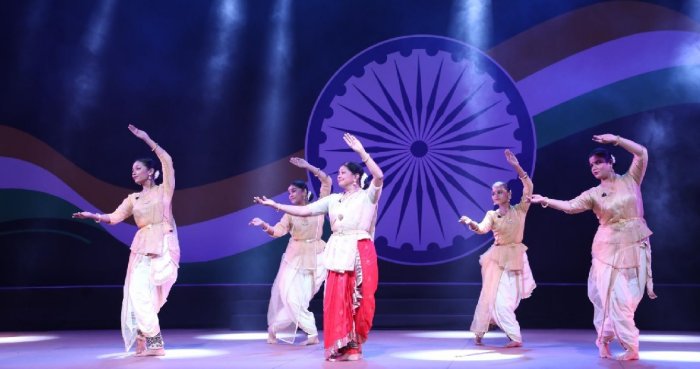 Rajashree Shirke's group Rajashree Shirke's confession was that, "When I received the concept and title "Naari Shakti" as the theme of my production, I started to recollect all the varied sources of history that I had read and which had nourished my knowledge, thought, understanding and expression of life and the essence of values to live with." She rummaged through Pre-Vedic times to the Puranas, to the pre-Independence era trying to understand Naari Shakti. The mortal and immortal women, who were powerful according to her, were Gargi, Draupadi, Mandodari, Vishpala, Onake Obavva, Kaikeyi Devi, Maa Durga and Jija Mata. The varied dimensions of power and strengths that they portrayed made her realize and see their images in the women of today - sometimes active, sometimes with dormant courage, righteousness, valour, intelligence and of course sheer physical strength that surpasses all. She found two distinct classifications through which she could portray these Nayikas (heroines). She found those women who showed mental strength - courage, righteous defiance, intellectual argument and truth and those who fought and defended their country, their culture from enemies within and without. Gargi showed her intellectual superiority and humility by asking questions about Time and Space to the great Rishi Yagyavalkya. Draupadi despite being disrobed, questions and mocks the so called heroes present in Kuru Sabha, who could not come to the aid of a helpless woman. Though Mandodari loved her husband she did not take his side in supporting him in his war with Ram. Vishpala, a commoner, fights till the last drop of her blood to save her country. Kaikeyi, an accomplished warrior and charioteer sacrifices her own finger to save her king from danger in battle. Onake Obavva, a warrior from Karnataka fought the soldiers of Hyder Ali and killed more than a hundred soldiers single-handedly with a pestle in order to prevent them from entering and invading Chitradurg fort. Goddess Durga Devi, the primal embodiment of strength and righteousness, who fearlessly fought and vanquished all demons, within and without. Jija Mata, the mother of Shivaji who in dire circumstances raised an entire flourishing town with iron-clad administration to bring up her son to be a lion-like ruler to fulfil her dream of an independent Maharashtra . Exploring Shakti through the lives of these heroines is a great source of inspiration for all women. Choreographing with different Indian classical dance styles has truly opened a new vista about the future Rajashree Shirke intends to chalk out for her learnt genre -Kathak dance. It has also opened her mind to delve into the realm of wonder and explore the wonder that is Bharat. Naari Shakti is truly the "elixir of greatness." A woman is unique, special and amazing in more ways than one can count. This production is a collage of historic events taken from the scriptures, epics and histories of our great Indian culture and heritage. Tales of noble and great women as mentioned have found their pride of place here. These stories have extraordinary instances where women have displayed uncommon bravery, wisdom, courage, love and above all, strength. The Indian forms used to depict these stories were Kathak, Sattriya nritya, Mohiniattam, Kathakali and Chhau. The Kathak dancers were Pranali Kakade, Asavari Waze, Vaishnavi Chavan, Sharvi Vaidya and Rajashree Shirke. Mohiniattam dancers were Sujatha Nair, Nidhi Nair, Jahnavi Premkumar. Sattriya dancers were Devika Borthakur, Akshata Mane, Sakshi Gaikwad and Yosha Roy. Chhau dancers were Akram Shaik and Samhita Chaudhury. Kathakali artiste was Renjish Nair, and the special characters in the production were enacted by Rajashree Shirke. Concept, direction, choreography, script and costume design were by Rajashree Shirke while music composition, lyrics, live vocal, rhythmic accompaniment were by Aniruddha Shirke. Sheetal Talpade was on the lights. 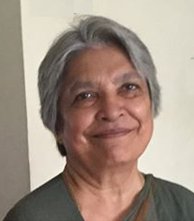 Tapati Chowdhurie trained under Guru Gopinath in Madras and was briefly with International Centre for Kathakali in New Delhi. Presently, she is a freelance writer on the performing arts. |